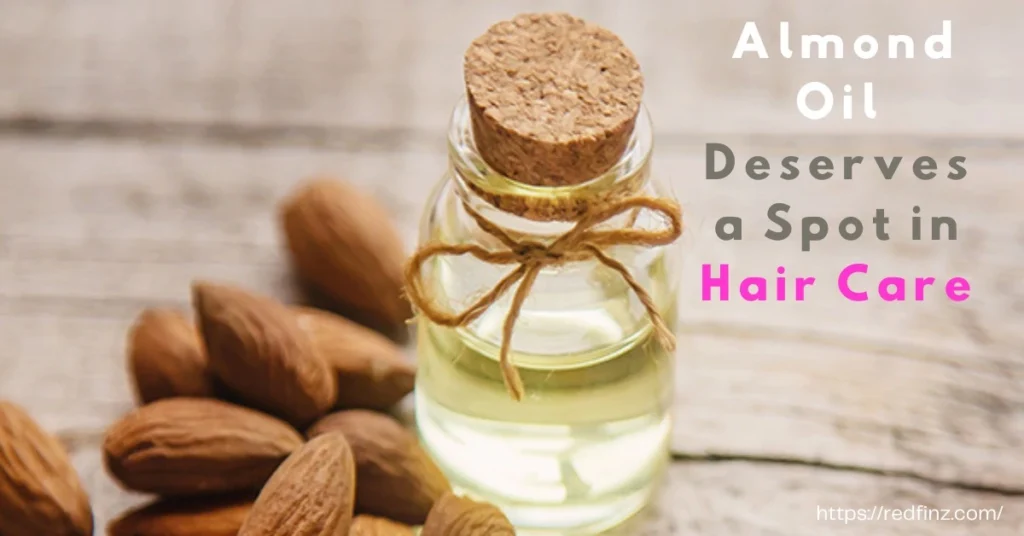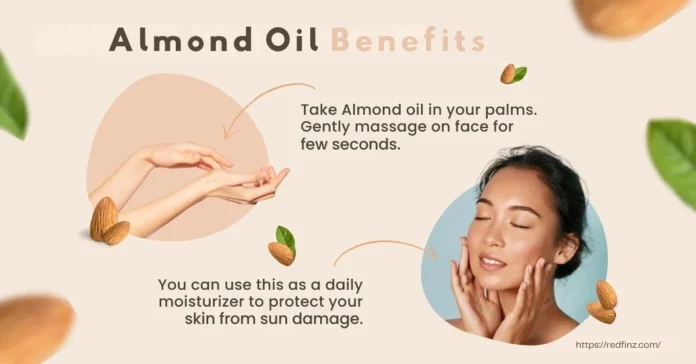Healthy hair isn’t just about luck. It’s about care, consistency, and the right ingredients. One of the simplest yet most effective ones is almond oil. For centuries, people have used it to maintain strong, shiny, and soft hair.
Almond oil delivers nutrients like biotin, fatty acids, and Vitamin E directly to the scalp and strands. These elements strengthen hair, reduce breakage, and protect it from daily damage. Whether used for a soothing scalp massage or as a lightweight leave-in conditioner, almond oil continues to prove why it belongs in every hair routine.
Why Almond Oil Deserves a Spot in Hair Car
Hair care routines have become complicated. From sprays to serums, the shelves are overflowing. Yet, many still face dullness, dryness, and thinning. That’s why almond oil has made a quiet comeback. It’s simple, effective, and works for nearly every hair type.
A Glimpse into Its Roots
Ancient Egyptians, Greeks, and Persians used almond oil in their grooming rituals. They valued it as a natural conditioner long before commercial products existed. Historical texts mention how it was used to soothe scalps, add shine, and reduce breakage. This old wisdom still holds true today.
What Makes It Stand Out
Almond oil comes in two main forms — sweet and bitter. Sweet almond oil is the safe, nourishing version often used for beauty care. It’s rich in vitamin E, omega fatty acids, and minerals like zinc and magnesium. Bitter almond oil, however, isn’t meant for topical or internal use because it can contain toxins if not processed correctly.
Sweet almond oil is light and easily absorbed. It doesn’t leave the scalp greasy, which makes it ideal for both daily and weekly care.
How Almond Oil Works on Hair
Hair health starts at the scalp. Almond oil nourishes from the root, improving blood circulation and moisture balance. Its small molecular structure helps it penetrate deep into the hair shaft instead of just coating the surface.
Studies in the Journal of Cosmetic Science show that oils rich in monounsaturated fats, like almond oil, improve strand elasticity and reduce breakage. Another report in the International Journal of Trichology notes that regular scalp massage with almond oil can reduce hair fall by improving follicle strength. So, it’s not just a folk remedy. Science supports it.
Top Benefits of Almond Oil for Hair

1. Restores Moisture and Softness
Dry hair breaks easily. Almond oil solves that. It seals moisture inside the hair shaft, keeping strands hydrated. Vitamin E acts as a natural conditioner, while omega fatty acids form a thin layer that protects against dryness.
For those living in dry or cold climates, applying almond oil twice a week can help maintain softness and prevent frizz.
2. Strengthens Weak Strands
Weak strands lead to split ends and breakage. Almond oil’s nutrients help repair and rebuild the hair structure. Magnesium, found in almonds, is known to improve hair elasticity and resistance.
A clinical study by the National Center for Biotechnology Information (NCBI) linked magnesium deficiency with hair fall. Almond oil helps address that issue directly through scalp absorption.
3. Boosts Hair Growth
The scalp is like soil — it needs nourishment to grow healthy strands. Almond oil increases blood flow, which brings more oxygen and nutrients to the roots.
People who massage their scalp with almond oil twice a week often notice thicker growth within 6–8 weeks. That’s not magic — it’s biology. Regular stimulation wakes up dormant follicles, and vitamin B7 (biotin) helps in new strand formation.
4. Reduces Hair Fall and Breakage
Hair fall can result from stress, diet, or poor scalp health. Almond oil addresses all three. It nourishes the follicles, reduces inflammation, and helps balance scalp oils.
It also reduces protein loss from hair strands, which is a common cause of breakage. According to data published in Dermatologic Therapy, plant-based oils rich in linoleic and oleic acids significantly reduce protein loss, keeping strands strong.
5. Fights Dandruff and Dry Scalp
Flaky scalp is often caused by dehydration or buildup. Almond oil gently loosens dead skin cells and moisturizes the scalp. Its antibacterial properties help reduce dandruff-causing microbes.
Consistent use keeps the scalp clean and comfortable. It’s a simple, natural fix for people tired of harsh anti-dandruff shampoos.
6. Adds Shine and Smoothness
Almond oil doesn’t just treat — it beautifies. The oil coats strands lightly, giving them a natural glow. Unlike silicone-based serums, it doesn’t weigh hair down.
Even a small amount after styling can boost shine. Vitamin E and fatty acids make the hair reflective and glossy under light.
7. Repairs Split Ends
Split ends happen when the protective cuticle layer wears down. Almond oil fills in those tiny gaps, sealing the ends temporarily. Over time, this reduces further splitting.
Hair stylists often recommend trimming split ends first, then using almond oil regularly to prevent them from coming back. It’s preventive care in a bottle.
8. Shields from Sun and Pollution
Every day, the hair faces dust, UV rays, and smoke. Almond oil acts as a protective coat against these factors. Its antioxidants neutralize harmful molecules that damage strands.
In regions with high UV exposure, applying a thin layer before stepping out can protect against dryness and color fading.
9. Helps Prevent Premature Graying
Gray hair isn’t just about age. It’s often tied to oxidative stress and loss of pigment cells. Almond oil’s antioxidants help slow this process.
Vitamin E and copper content maintain melanin production, which gives hair its natural color. While it can’t reverse graying, it may delay its onset with regular use.
10. Improves Scalp Health
Healthy hair starts at the root. Almond oil improves scalp texture and balances natural oils. Its lightness ensures pores stay clear.
A 5-minute scalp massage increases oxygen flow and nutrient delivery. People who stick to this routine often notice better volume and thickness over time.
How to Use Almond Oil the Right Way

There’s no single “perfect” way to apply almond oil. What matters is consistency and proper technique.
- Warm a few tablespoons of almond oil until it’s slightly above room temperature.
- Apply directly to the scalp using fingertips.
- Massage gently in circular motions for 5–10 minutes.
- Leave on for 45 minutes or overnight under a shower cap.
- Rinse with a mild shampoo.
This method ensures deep absorption and maximum effect.
DIY Hair Masks with Almond Oil
For dry hair: Mix almond oil with honey and yogurt.
For frizz control: Combine almond oil with coconut oil and a few drops of lavender oil.
For faster growth: Blend almond oil with castor oil and a little rosemary oil.
For dandruff: Mix almond oil with aloe vera gel and a few drops of lemon juice.
Each combination targets a specific problem while keeping the process natural and safe.
How Often Should Almond Oil Be Used?
Twice a week is ideal for most hair types. People with oily scalps can limit it to once a week. For dry or chemically treated hair, three times weekly may help restore balance.
Leaving the oil overnight isn’t mandatory. Even 45 minutes is enough for visible improvement with consistent use.
Almond Oil vs. Other Hair Oils

Coconut Oil vs. Almond Oil
Coconut oil penetrates deeper but can be heavy for fine hair. Almond oil, being lighter, works better for everyday use. It’s less likely to clog pores or cause buildup.
Argan Oil vs. Almond Oil
Argan oil is richer but more expensive. Almond oil offers similar smoothness at a lower cost, with added benefits like scalp nourishment and vitamin B content.
Castor Oil vs. Almond Oil
Castor oil supports thick growth but is sticky. Almond oil balances texture and shine without the heaviness, making it more versatile.
Choosing the Right Almond Oil
Look for cold-pressed sweet almond oil. It’s extracted without heat, keeping nutrients intact. Avoid refined oils that may have lost vitamins during processing.
A good indicator of quality is the label — it should list Prunus amygdalus dulcis as the main ingredient, with no added preservatives or fragrance.
Possible Side Effects and Precautions
Almond oil is generally safe. However, anyone allergic to nuts should do a patch test first. Apply a small drop to the inner elbow and wait 24 hours. If no redness or irritation occurs, it’s safe to use.
Also, avoid using it on a dirty scalp. Oil traps dirt, which can cause buildup and irritation if not cleaned properly.
Expert Opinions and Real Results
Trichologists agree that natural oils like almond oil can complement medical treatments for hair loss. While it’s not a miracle cure, it supports scalp health, which is key for long-term improvement.
Many users report softer texture and easier detangling within two weeks of regular use. After a month, hair feels stronger and looks more vibrant.
Conclusion
Almond oil doesn’t promise overnight magic. It offers steady, visible progress. With vitamins, minerals, and fatty acids working together, it supports every part of hair health — from root strength to shine.
For anyone tired of chemical-heavy products, almond oil brings back simplicity and results. It’s a quiet reminder that sometimes, the best solutions are the oldest ones.






